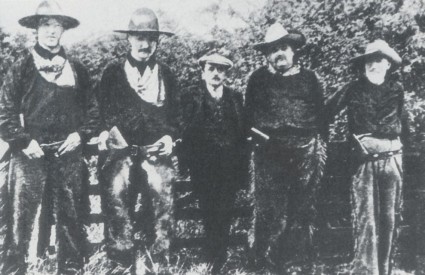Extollager
Well-Known Member
- Joined
- Aug 21, 2010
- Messages
- 9,241
The 90th Anniversary of Arthur Machen’s Duds and Dulls
In 1924, Spurr and Swift published Precious Balms, a compilation of reviews, mostly unfavorable, of Machen’s books, a 250-copy edition signed by Machen. Such was the success of the book that the publisher clamoured for a successor. In 1926 they issued Duds and Dulls in an edition of 30 copies made with a tooled morocco leather binding and hand-made paper, sporting wide margins and large print, and signed, once again, by Machen. Like The Glitter of the Brook and With the Gods in Spring (1932), this book includes just two items.
The slim volume begins with Machen’s sole attempt at a silent movie script, “The Outlaws of Wildcat Cañon.” Machen introduces “Cañon” with an explanation of its origin. In 1914, J. M. Barrie, G. K. Chesterton, George Bernard Shaw, critic William Archer, and philanthropist Lord Howard de Walden had made a silent movie with a cowboy theme. An account of the jape, with a photo of the costumed actors, appears in Chesterton’s Autobiography (1936).

[Pictured, left to right: Lord Howard de Walden, William Archer, Arthur Machen, G. K. Chesterton, George Bernard Shaw]
It turns out that, such was the success of their film, they wished to create a sequel. Stumped for a plot, they approached Machen, urging that his experience as a strolling player would enable him to understand the dramatic requirements of the cinematic medium.
Machen says that, soon thereafter, he sat up late one night with paper, strong tobacco, and green tea, determined to produce a simple script and mise-en-scène. With windows shut tight and a rug across the bottom of the door to keep out drafts, he laid fresh coal on the fire throughout the night. By morning, despite his aching head and icy feet, the sheets were filled. His scenario involves two ambushes, one train robbery, and a “Colorado Necktie Party,” in which vigilantes bring justice to a crew of outlaws.
Machen’s note relates that Chesterton was enthusiastic, praising the script as a true penny dreadful thriller, but Shaw and the peer refused to have anything to do with it, and so the film was never made.
The book’s second piece is “The Ineffable Spectacle,” one of Machen’s leisurely London reminiscences. Luring the reader on with the promise of a most curious relation, Machen leads up in the final paragraph to the remarkable anecdote of his meeting at Reigate with Mr. Campo Tosto, who lived at Burnt Green, where he defended his treasures with a bow and arrow.
Spurr and Swift were disappointed with the reception of their second Machen book. By 1926 the Machen boom had tapered off. According to Sweetser and Goldstone, they sold or gave away only nine copies. Occasionally one of these copies is offered, its pages still uncut, in the antiquarian book trade. The remaining 21 books were casualties, years later, of a wartime paper drive.
© 2016 Dale Nelson
In 1924, Spurr and Swift published Precious Balms, a compilation of reviews, mostly unfavorable, of Machen’s books, a 250-copy edition signed by Machen. Such was the success of the book that the publisher clamoured for a successor. In 1926 they issued Duds and Dulls in an edition of 30 copies made with a tooled morocco leather binding and hand-made paper, sporting wide margins and large print, and signed, once again, by Machen. Like The Glitter of the Brook and With the Gods in Spring (1932), this book includes just two items.
The slim volume begins with Machen’s sole attempt at a silent movie script, “The Outlaws of Wildcat Cañon.” Machen introduces “Cañon” with an explanation of its origin. In 1914, J. M. Barrie, G. K. Chesterton, George Bernard Shaw, critic William Archer, and philanthropist Lord Howard de Walden had made a silent movie with a cowboy theme. An account of the jape, with a photo of the costumed actors, appears in Chesterton’s Autobiography (1936).

[Pictured, left to right: Lord Howard de Walden, William Archer, Arthur Machen, G. K. Chesterton, George Bernard Shaw]
It turns out that, such was the success of their film, they wished to create a sequel. Stumped for a plot, they approached Machen, urging that his experience as a strolling player would enable him to understand the dramatic requirements of the cinematic medium.
Machen says that, soon thereafter, he sat up late one night with paper, strong tobacco, and green tea, determined to produce a simple script and mise-en-scène. With windows shut tight and a rug across the bottom of the door to keep out drafts, he laid fresh coal on the fire throughout the night. By morning, despite his aching head and icy feet, the sheets were filled. His scenario involves two ambushes, one train robbery, and a “Colorado Necktie Party,” in which vigilantes bring justice to a crew of outlaws.
Machen’s note relates that Chesterton was enthusiastic, praising the script as a true penny dreadful thriller, but Shaw and the peer refused to have anything to do with it, and so the film was never made.
The book’s second piece is “The Ineffable Spectacle,” one of Machen’s leisurely London reminiscences. Luring the reader on with the promise of a most curious relation, Machen leads up in the final paragraph to the remarkable anecdote of his meeting at Reigate with Mr. Campo Tosto, who lived at Burnt Green, where he defended his treasures with a bow and arrow.
Spurr and Swift were disappointed with the reception of their second Machen book. By 1926 the Machen boom had tapered off. According to Sweetser and Goldstone, they sold or gave away only nine copies. Occasionally one of these copies is offered, its pages still uncut, in the antiquarian book trade. The remaining 21 books were casualties, years later, of a wartime paper drive.
© 2016 Dale Nelson

